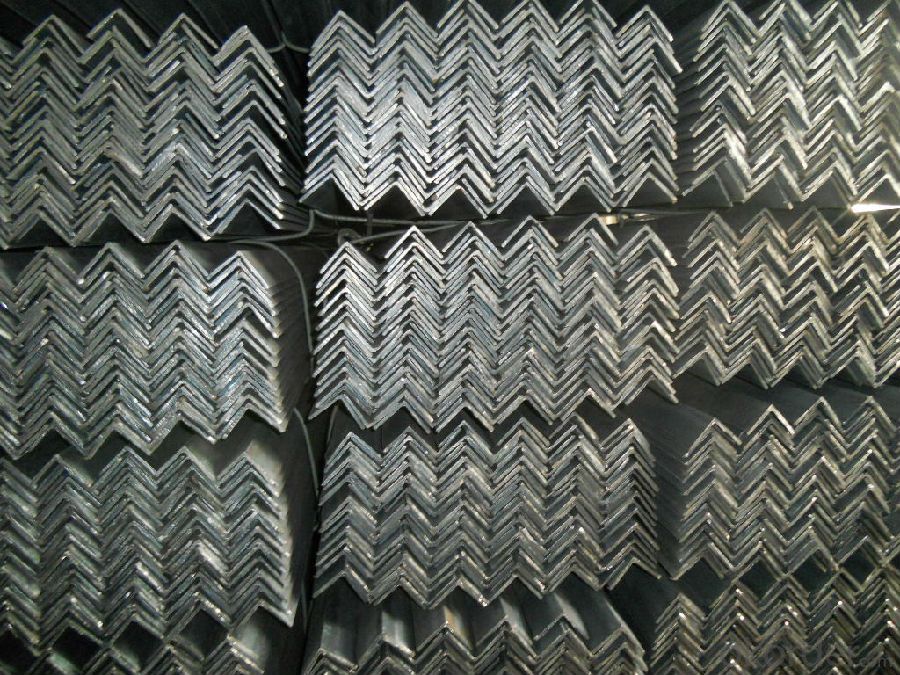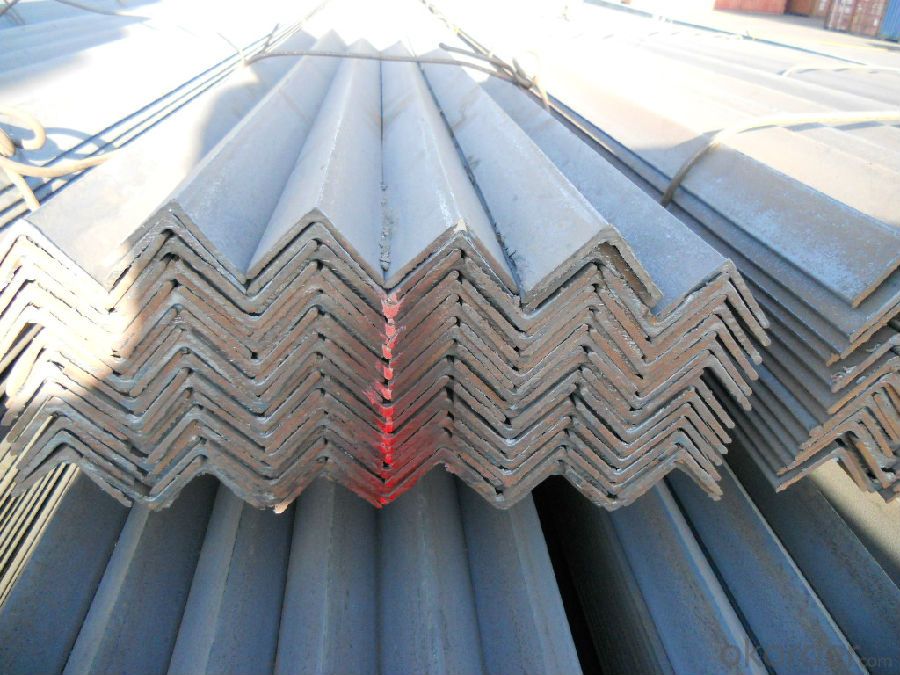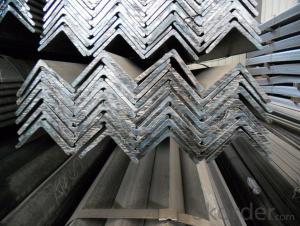Stainless Steel Angles with High Quatity Grade: SS200,300,400 Series
- Loading Port:
- Tianjin
- Payment Terms:
- TT OR LC
- Min Order Qty:
- 100 m.t.
- Supply Capability:
- 50000 m.t./month
OKorder Service Pledge
OKorder Financial Service
You Might Also Like
1. Structure of Angle Steel Description
Angle steel has equal angle, unequal angle. Standards: GB,ASTM,BS,AISI,DIN,JIS Material:Material: GB Q235B, Q345B or Equivalent; ASTM A36; EN 10025, S235JR, S355JR; JIS G3192, SS400; SS540.
Grade: SS200,300,400 series
Size: 25×25×3 mm-100×100×10mm
Process: HRAP
Length: 2-6m
Shape: Equal
Delivery: within 20 days
MOQ: 1 ton
Certificate: ISO 9001:2008, SGS
Package:Standard Export Packing, or put into wooden boxes according to your requirement
Application: Construction, Marine, Industry and so on
Name | Stainless Steel Angles | ||||||
Standard | ASTM A554, A312, A249, A269 and A270 | ||||||
Material Grade | 304,316,201,202, 316L,430 | ||||||
Length | 6m or as customers' request | ||||||
Tolerance | a) thickness: +/-0. 15mm | ||||||
b) Length:+/-4. 5mm - 0mm | |||||||
Surface | 180G, 320G, 400G Satin / Hairline(Matt Finish, Brush, Dull Finish) 400G, 500G, 600G or 800G Mirror finish | ||||||
Application | Decoration construction, upholstery, industry instruments | ||||||
Test | Squash test, Extended test, Water pressure test, Crystal rot test, Heat treatment, NDT | ||||||
Chemical Composition of Material | Composition Material | 201 | 202 | 304 | 316L | 430 | |
C | ≤0.15 | ≤0.15 | ≤0.08 | ≤0.08 | ≤0.12 | ||
Si | ≤1.00 | ≤1.00 | ≤1.00 | ≤1.00 | ≤1.00 | ||
Mn | 5.5-7.5 | 7.5-10 | ≤2.00 | ≤2.00 | ≤1.00 | ||
P | ≤0.06 | ≤0.06 | ≤0.045 | ≤0.045 | ≤0.040 | ||
S | ≤0.03 | ≤0.03 | ≤0.030 | ≤0.030 | ≤0.030 | ||
Cr | 16-18 | 17-19 | 18-20 | 16-18 | 16-18 | ||
Ni | 3.5-5.5 | 4-6 | 8-10.5 | 10-14 | |||
Mo | 2.0-3.0 | ||||||
Mechanical Property | Material Item | 201 | 202 | 304 | 316L | ||
Tensile Strength | ≥535 | ≥520 | ≥520 | ≥520 | |||
Yield Strength | ≥245 | ≥205 | ≥205 | ≥205 | |||
Extension | ≥30% | ≥30% | ≥35% | ≥35% | |||
Hardness (HV) | <253< p=""> | <253< p=""> | <200< p=""> | <200< p=""> | |||
2.Main Features of angle steel
Broad-spectrum
High quantity
High strength
3.Usage & Applications of High Quatity Grade: SS200,300,400 Series Stainless Steel Angles
Trusses
Transmission towers;
Telecommunication towers;
Bracing for general structures;
Stiffeners in structural use.
4.Packaging & Delivery of GB Q235 Angle Steel
Transportation: the goods are delivered by truck from mill to loading port, the maximum quantity can be loaded is around 40MTs by each truck. If the order quantity cannot reach the full truck loaded, the transportation cost per ton will be little higher than full load.
With bundles and load in 20 feet/40 feet container, or by bulk cargo, also we could do as customer's request.
Marks:
Color mark: There will be color marking on both end of the bundle for the cargo delivered by bulk vessel. That makes it easily to distinguish at the destination port.
Tag mark: There will be tag mark tied up on the bundles. The information usually including supplier logo and name, product name, made in China, shipping marks and other information request by the customer.


5.FAQ
We have organized several common questions for our clients,may help you sincerely:
①How about your company?
A world class manufacturer & supplier of castings forging in carbon steel and alloy steel,is one of the large-scale professional investment casting production bases in China,consisting of both casting foundry forging and machining factory. Annually more than 8000 tons Precision casting and forging parts are exported to markets in Europe,America and Japan. OEM casting and forging service available according to customer’s requirements.
②How to guarantee the quality of the products?
We have established the international advanced quality management system,every link from raw material to final product we have strict quality test;We resolutely put an end to unqualified products flowing into the market. At the same time, we will provide necessary follow-up service assurance.
③How long can we receive the product after purchase?
- Q:Can steel angles be used for architectural purposes?
- Yes, steel angles can be used for architectural purposes. They are commonly used in the construction industry for various architectural applications such as support brackets, frames, and reinforcements. Steel angles provide structural stability and can be easily customized and integrated into architectural designs to meet specific requirements.
- Q:What are the standard lengths of steel angles?
- The specific requirements and standards of various industries and applications determine the varying standard lengths of steel angles. Typically, these standard lengths range from 20 to 40 feet. These lengths find extensive usage in construction, manufacturing, and structural applications. It is worth mentioning that steel angles can be tailored and adjusted to meet the specific length requirements of a project.
- Q:How do steel angles resist corrosion?
- Passivation is the process by which steel angles develop a protective layer on their surface, which helps them withstand corrosion. This layer acts as a barrier against moisture, oxygen, and chemicals that are corrosive to the steel. Typically, steel angles are made from stainless steel, which contains at least 10.5% chromium. Chromium plays a crucial role in the formation of a thin layer of chromium oxide on the steel's surface. This oxide layer is invisible but highly stable, preventing further corrosion. The chromium oxide layer acts as a physical barrier, shielding the underlying steel from the harmful effects of the environment. It is also self-repairing, meaning that if it gets damaged or scratched, it will naturally regenerate and restore its protective properties. Stainless steel angles may also contain other alloying elements like nickel and molybdenum, which enhance their resistance to corrosion. These elements contribute to the formation of a more stable oxide layer and provide added protection against localized corrosion, such as pitting and crevice corrosion. To further enhance their corrosion resistance, steel angles can be treated with various surface finishes or coatings. These treatments, like hot-dip galvanizing, electroplating, or applying organic coatings, create additional layers that act as extra barriers, preventing corrosive substances from reaching the steel surface. In summary, steel angles resist corrosion by forming a protective layer of chromium oxide, which acts as a barrier against corrosive elements. The inclusion of other alloying elements and the application of surface treatments further enhance their ability to withstand corrosion in different environments.
- Q:Can steel angles be used as reinforcement in concrete slabs?
- Concrete slabs can indeed benefit from the use of steel angles for reinforcement. These L-shaped structural steel components, commonly utilized in construction due to their durability and strength, can significantly enhance the load-bearing capacity of a concrete slab. Furthermore, they help prevent any potential cracks or structural failure. Specifically, steel angles provide added support and strength to the concrete, especially in areas where heavy loads or concentrated forces are anticipated. By incorporating steel angles as reinforcement, the concrete slab becomes more resistant to bending, tension, and shearing forces, resulting in a structurally sound slab that can withstand higher loads. It is crucial to ensure the proper design and placement of steel angles, following the guidelines and specifications provided by structural engineers, to guarantee the optimal reinforcement and performance of the concrete slab.
- Q:Can steel angles be galvanized?
- Indeed, galvanizing is a feasible option for steel angles. Galvanization entails the application of a safeguarding zinc coating onto steel to inhibit rust and corrosion. To galvanize steel angles, one can either immerse them in a heated bath of molten zinc or employ a specialized spray or paint technique for zinc application. Galvanized steel angles find widespread use in the realms of construction, manufacturing, and outdoor settings, where defense against rust and corrosion is imperative.
- Q:Are steel angles available in different alloys?
- Yes, steel angles are available in different alloys.
- Q:What are the different surface finishes available for galvanized steel angles?
- There are several different surface finishes available for galvanized steel angles. 1. Smooth: This is the most common surface finish for galvanized steel angles. It provides a smooth and polished appearance, making it suitable for a wide range of applications. 2. Matte: Matte finish is achieved by applying a chemical treatment to the galvanized steel angles. This finish provides a non-reflective surface, making it ideal for applications where glare is a concern. 3. Textured: Textured finish involves adding a textured pattern to the surface of the galvanized steel angles. This can be done through embossing or by applying a textured coating. The textured surface enhances grip and provides a decorative element. 4. Powder coated: Galvanized steel angles can also be powder coated, which involves applying a dry powder to the surface and then curing it in a high-temperature oven. Powder coating offers a durable and attractive finish, with a wide range of color options available. 5. Painted: Another option is to paint the galvanized steel angles. This can be done using either oil-based or water-based paints. Painting adds an extra layer of protection against corrosion and can be customized to match specific color requirements. Overall, the choice of surface finish for galvanized steel angles depends on the intended use, aesthetic preferences, and the level of protection required against corrosion. It is important to consider the environmental conditions and the specific needs of the application when selecting a surface finish.
- Q:How do steel angles perform under vibration or resonance conditions?
- Steel angles are generally stable and perform well under vibration or resonance conditions. Due to their rigid structure and strong material properties, steel angles have a high resistance to vibrations and can effectively dampen resonance effects. This makes them suitable for various applications where stability and durability are required, such as in construction and engineering projects.
- Q:Can steel angles be used for foundation reinforcement?
- Yes, steel angles can be used for foundation reinforcement. Steel angles are commonly used in construction projects for their strength and durability. When properly installed and secured, steel angles can provide additional support and stability to a foundation, helping to prevent cracks, settlement, and other structural issues.
- Q:What are the different methods of impact testing for steel angles?
- To assess the toughness and resistance of steel angles, engineers and manufacturers have access to various impact testing methods. These include the Charpy V-notch test, the Izod test, and the drop weight test. The Charpy V-notch test is widely utilized and involves placing a notched specimen of the steel angle in a pendulum hammer. Upon release, the hammer swings down and strikes the specimen. The energy absorbed by the specimen before it fractures determines the material's impact toughness. Similarly, in the Izod test, a notched specimen is clamped vertically, and a pendulum hammer strikes it horizontally. The absorbed energy is then measured to evaluate the specimen's impact resistance. Finally, the drop weight test requires dropping a weight onto a supported specimen from a specific height. The impact energy is calculated based on the weight and drop height. The specimen's deformation and fracture behavior are analyzed to determine its impact toughness. These diverse impact testing methods provide engineers and manufacturers with vital insights into the ability of steel angles to endure sudden impacts or shock loads. By assessing the material's toughness and resistance, these tests aid in designing structures and selecting suitable materials for various applications.
1. Manufacturer Overview |
|
|---|---|
| Location | |
| Year Established | |
| Annual Output Value | |
| Main Markets | |
| Company Certifications | |
2. Manufacturer Certificates |
|
|---|---|
| a) Certification Name | |
| Range | |
| Reference | |
| Validity Period | |
3. Manufacturer Capability |
|
|---|---|
| a)Trade Capacity | |
| Nearest Port | |
| Export Percentage | |
| No.of Employees in Trade Department | |
| Language Spoken: | |
| b)Factory Information | |
| Factory Size: | |
| No. of Production Lines | |
| Contract Manufacturing | |
| Product Price Range | |
Send your message to us
Stainless Steel Angles with High Quatity Grade: SS200,300,400 Series
- Loading Port:
- Tianjin
- Payment Terms:
- TT OR LC
- Min Order Qty:
- 100 m.t.
- Supply Capability:
- 50000 m.t./month
OKorder Service Pledge
OKorder Financial Service
Similar products
New products
Hot products
Related keywords




























